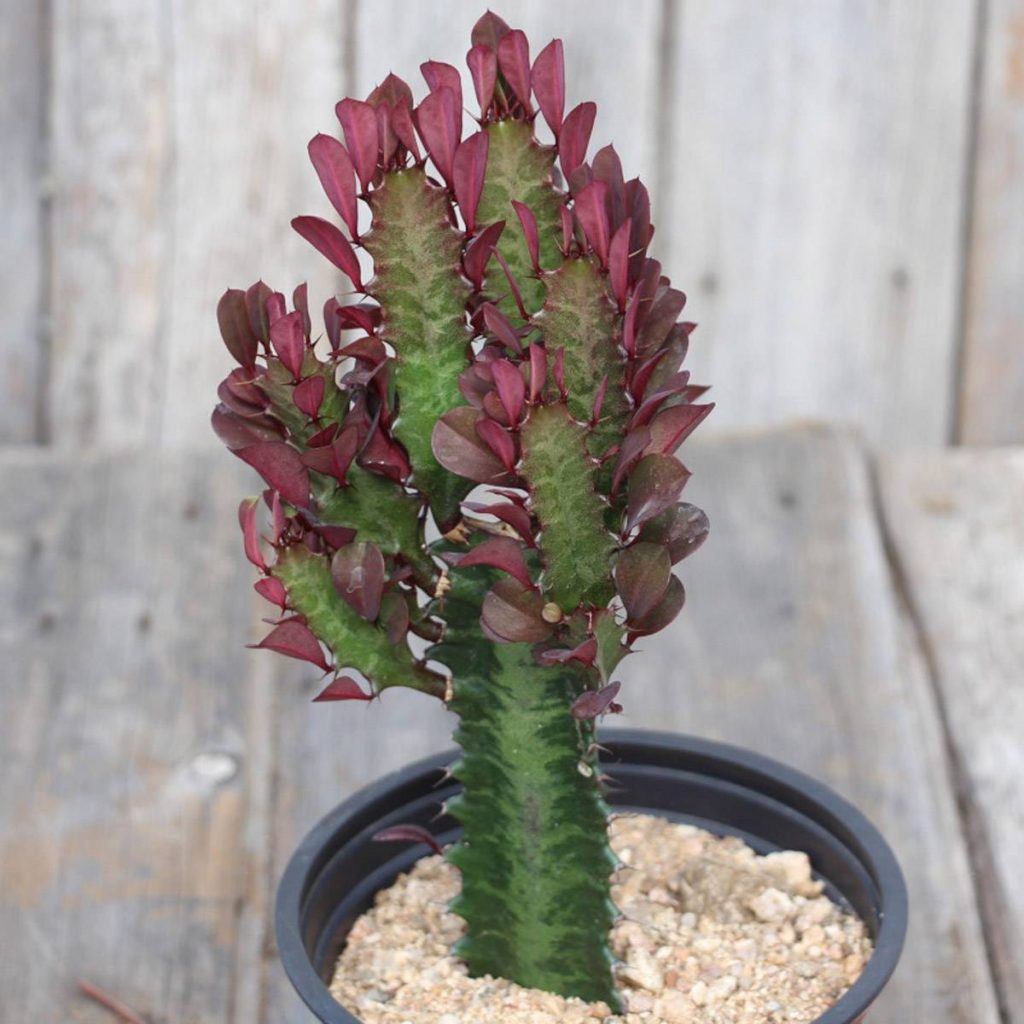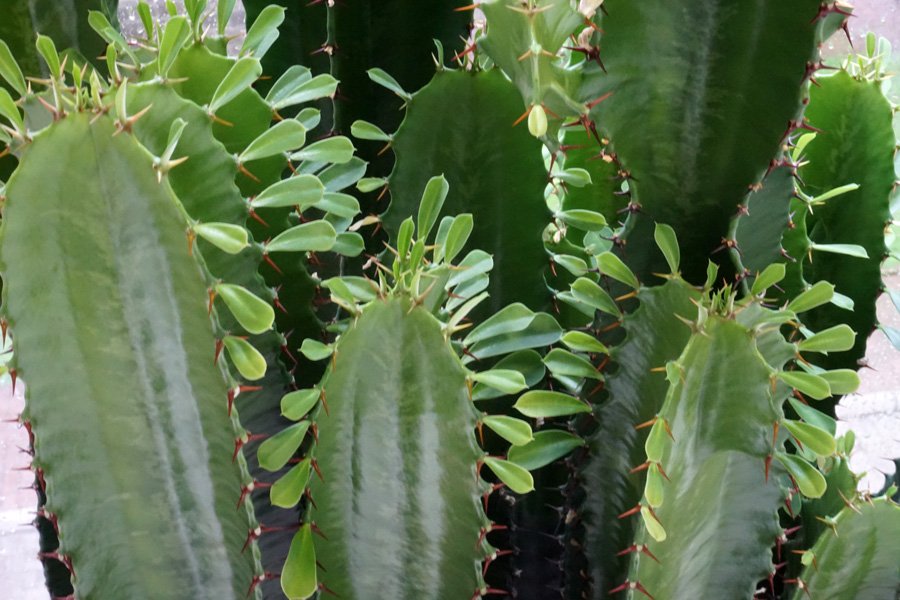The African Milk Tree, scientifically known as Euphorbia trigona, is a fascinating and visually striking plant that has captured the interest of plant enthusiasts around the globe. In this comprehensive guide, we will delve into everything you need to know about caring for this unique succulent, from its intriguing features to practical care tips.
Overview of the African Milk Tree (Euphorbia trigona)
1.1. Origin and Key Characteristics
The African Milk Tree hails from Central Africa and is known for its unique appearance. It boasts a sturdy, upright growth habit, featuring triangular stems lined with thorns and small leaves.
1.2. Popular Nicknames
This plant has garnered several nicknames, including:
- Candelabra Cactus: Due to its branching, candle-like structure.
- Cathedral Cactus: Its towering form resembles cathedral spires.
- Friendship Cactus and Good Luck Cactus: Often given as gifts symbolizing friendship and good fortune.
1.3. Intriguing Features
Key features of the African Milk Tree include:
- Distinctive Triangular Stems: These are adorned with sharp thorns and small, teardrop-shaped leaves.
- Rapid Growth: This plant can grow 1-2 feet per year, reaching heights of 6-9 feet, making it a dramatic addition to any indoor space.
1.4. Toxicity Warning
It’s important to note the African Milk Tree’s toxicity:
- Sap Toxicity: The sap is irritating to the skin and toxic if ingested. Caution should be exercised, especially around pets and children.

Care Guide for African Milk Tree
2.1. Ideal Growing Conditions
To thrive, the Abyssinian Euphorbia requires specific conditions:
- Bright Indirect Light: This plant loves bright, indirect sunlight. A spot near a sunny window where direct sunlight is diffused is ideal.
- Well-Drained Soil: Use a well-draining soil mix, typically used for cacti and succulents, to prevent root rot.
2.2. Watering Strategies
Understanding the watering needs is crucial:
- Drought-Tolerant Nature: As a succulent, it’s important not to overwater. Let the soil dry out completely between waterings.
- Sparse Watering: In cooler months, reduce watering frequency as the plant goes into a dormant state.
2.3. Fertilization Routine
Fertilization is key for robust growth:
- Spring and Summer Feeding: Fertilize monthly during the growing season with a balanced, diluted fertilizer to encourage growth.
Pruning African Milk Tree
3.1. Importance of Pruning
Pruning is essential for maintaining the plant’s shape and preventing it from becoming top-heavy.
3.2. Pruning Techniques
When pruning, consider the following:
- Safety First: Wear gloves and eye protection to avoid contact with the sap.
- Effective Pruning: Cut back any overgrown branches to maintain balance. Pruning can also encourage branching, leading to a fuller plant.
3.3. Post-Pruning Care
After pruning, allow the cut areas to callous over before resuming your regular watering schedule. This helps prevent infection and sap leakage.

Propagation Methods
3.1. Propagation Overview 🌱
Propagation, the process of creating new plants from an existing plant, is a fascinating and rewarding aspect of gardening. Euphorbia Trigona can be propagated quite easily, making it a great project for those looking to expand their plant collection or share with friends. Understanding the right techniques is key to success.
3.2. Cautionary Steps 🚫
When propagating the African Milk Tree, safety is paramount. The plant’s sap is toxic and can cause irritation, so always wear gloves and handle with care. Here’s a step-by-step guide to propagating from cuttings:
- Select a Healthy Cutting: Look for a robust, healthy stem that’s at least a few inches long.
- Make the Cut: Using a clean, sharp knife or scissors, make a cut on the parent plant. Be precise and quick.
- Let it Dry: The cutting needs to form a callus. Leave it in a dry, warm place for a few days until the cut end dries out.
- Plant the Cutting: Once calloused, plant the cutting in a well-draining soil mix. A blend designed for cacti and succulents is ideal.
- Water Sparingly: Initially, water lightly to encourage root growth, then gradually increase as the plant establishes.
3.3. Seed Growth Considerations 🌼
While Euphorbia Trigona can technically be grown from seeds, this method is often discouraged. Seed propagation is slower and less reliable compared to cuttings. For those who do venture into seed growth, remember:
- Potting and Repotting: Choose a pot that allows room for growth. Fresh soil enriched with organic matter can boost health and vitality.
Seasonal Considerations and Challenges
4.1. Overwintering Guidelines ❄️
In colder climates, the African Milk Tree requires special attention during the winter months. Being a tropical plant, it doesn’t fare well in cold temperatures. Here’s how to help your plant thrive:
- Indoor Placement: Before the first frost, bring your Euphorbia Trigona indoors.
- Ideal Conditions: Place it in a spot where it can receive plenty of indirect sunlight.
- Reduce Watering: During winter, the plant’s growth slows down, so reduce the frequency of watering.
4.2. Fungal Issues 🍄
Overwatering is a common mistake with succulents and can lead to fungal problems. Here are some tips to prevent these issues:
- Well-Draining Soil: Ensure the soil allows for quick drainage.
- Monitor Watering: Only water when the top inch of soil is completely dry.
- Good Air Circulation: Keep the plant in an area with adequate airflow to help keep the foliage dry.
4.3. Common Pests 🐛
Mealybugs can be a nuisance for the African Milk Tree. These pests thrive in the crevices of the plant and can be identified by their cotton-like appearance. To combat them:
- Regular Inspection: Check your plant frequently for signs of pests.
- Isopropyl Alcohol: Apply a solution of isopropyl alcohol with a cotton swab to remove the bugs.
- Neem Oil: As a natural pesticide, neem oil can be effective in keeping mealybugs at bay.
Additionally, yellowing leaves can be a sign of overwatering or poor drainage. Adjust your care routine accordingly to prevent further issues.

African Milk Tree (Euphorbia Trigona) FAQ: Your Comprehensive Guide 🌵
What Is the African Milk Tree?
The African Milk Tree, scientifically known as Euphorbia trigona, and also known as Abyssinian Euphorbia, is a popular houseplant. Despite its common name, it’s actually a succulent and not a tree. It’s native to Central Africa and is known for its upright growth, reaching 1 to 2 feet annually, and potentially up to 9 feet tall.
What Are the Different Varieties of African Milk Tree?
There are a few varieties, with Euphorbia trigona rubra, also known as ‘Royal Red’, being quite popular due to its striking red hue. Another variety is the standard green Abyssinian Euphorbia. Both varieties share similar care requirements.
How Do I Care for My African Milk Tree?
African Milk Tree care involves:
- Light: It thrives in full sun to partial shade. Bright light is essential for its growth.
- Watering: As a drought-tolerant plant, allow the soil to dry out between waterings. Overwatering can damage the plant.
- Soil: Use well-draining, sandy soil. Euphorbias prefer soil that is not too moist.
- Indoor Plant Care: When grown indoors, place it in a spot with bright sunlight and rotate the plant for even growth.
Is the African Milk Tree Easy to Grow Indoors?
Yes, it’s a hardy plant that’s easy to grow indoors. It prefers bright sunlight but can tolerate lower light conditions. Its shallow root system makes it a good container plant.
How Fast Does the African Milk Tree Grow?
The African Milk Tree grows best in conditions that mimic its native habitat. Indoors, it can grow about 1 to 2 feet per year, reaching about half of its maximum height compared to its outdoor counterparts.
What Are the Watering Needs of the Abyssinian Euphorbia?
It’s a succulent plant, so it’s important to let the soil dry out between waterings. Overwatering or underwatering can cause issues. The plant needs less water in the winter.
Does the African Milk Tree Bloom?
While it can bloom, flowering is rare in indoor conditions. The blooms, when they occur, are small and not particularly showy.
What Are Some Common Problems with the African Milk Tree?
Common issues include:
- Overwatering: Leading to root rot.
- Underwatering: Causes leaves and stems to wilt or dry out.
- Pests: Mealybugs can be a problem; treat them with rubbing alcohol.
- Toxic Sap: The milky sap is toxic and can cause irritation, so always wear gloves when handling the plant.
Is the African Milk Tree Toxic?
Yes, the white sap of the plant is toxic and can cause irritation. It’s advisable to keep the plant away from pets or children and wear gloves to protect your hands when handling it.
How Do I Propagate the African Milk Tree?
Propagation is usually done through cuttings. Allow the cutting to callous for a few days before putting it in a solution of water or directly in soil. Remember, the sap can be irritating, so take precautions.
Can the Abyssinian Euphorbia Get Top Heavy?
Yes, it can get top heavy as it grows taller. It’s important to provide adequate support or prune the plant to manage its size.
How Often Should I Repot My Euphorbia trigona?
Repotting should be done when the plant has outgrown its current pot or the soil has become compacted. This is typically every few years.
Introduction
Nicki Mann, based in Portland, Oregon, is a good writer and houseplant enthusiast. With her background in environmental science, Nicki specializes in indoor gardening, focusing on sustainable and organic practices.
Experience
Her interest in houseplants began in her mid-twenties, leading to a career writing articles about indoor plant care and eco-friendly gardening for various websites.
Education
Nicki holds a Bachelor of Science in Environmental Studies from the University of Oregon, which underpins her approach to indoor gardening. She continually enhances her knowledge through horticulture and environmental sustainability workshops.
Personal Life
Nicki, an avid nature lover, enjoys exploring the Pacific Northwest's trails. She's active in community gardening and lives with her two rescue cats, who share her interest in her growing collection of houseplants.


